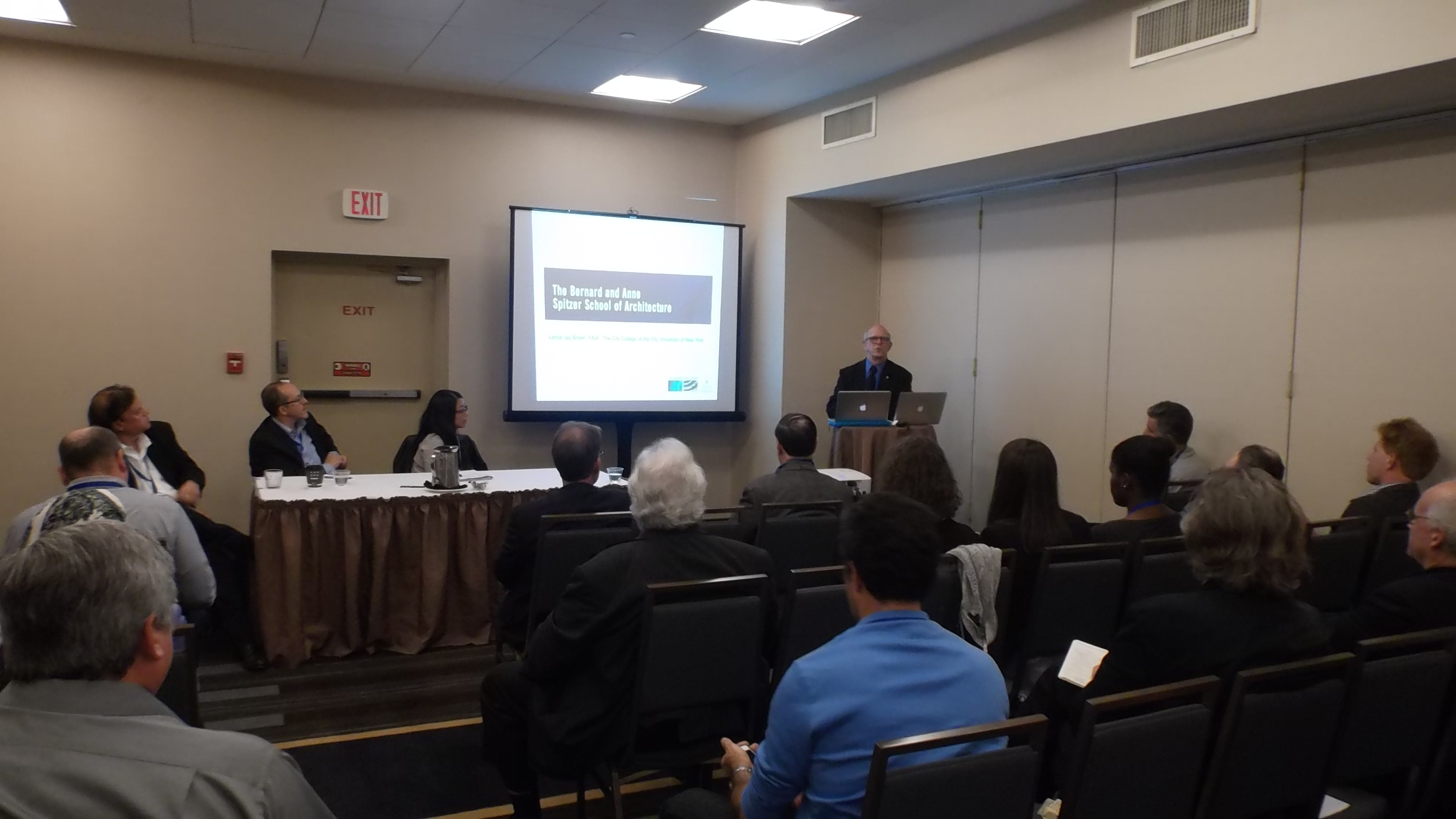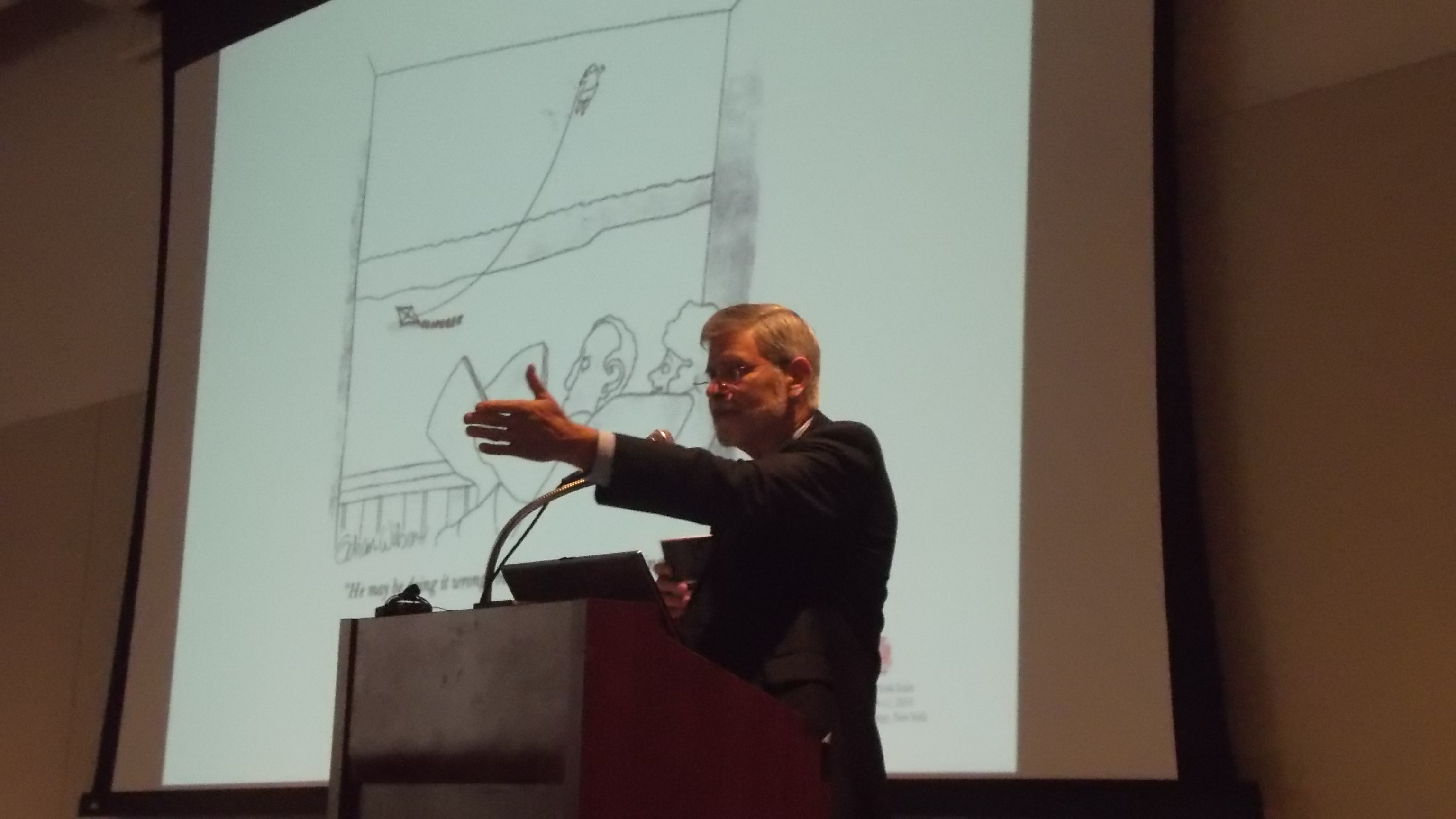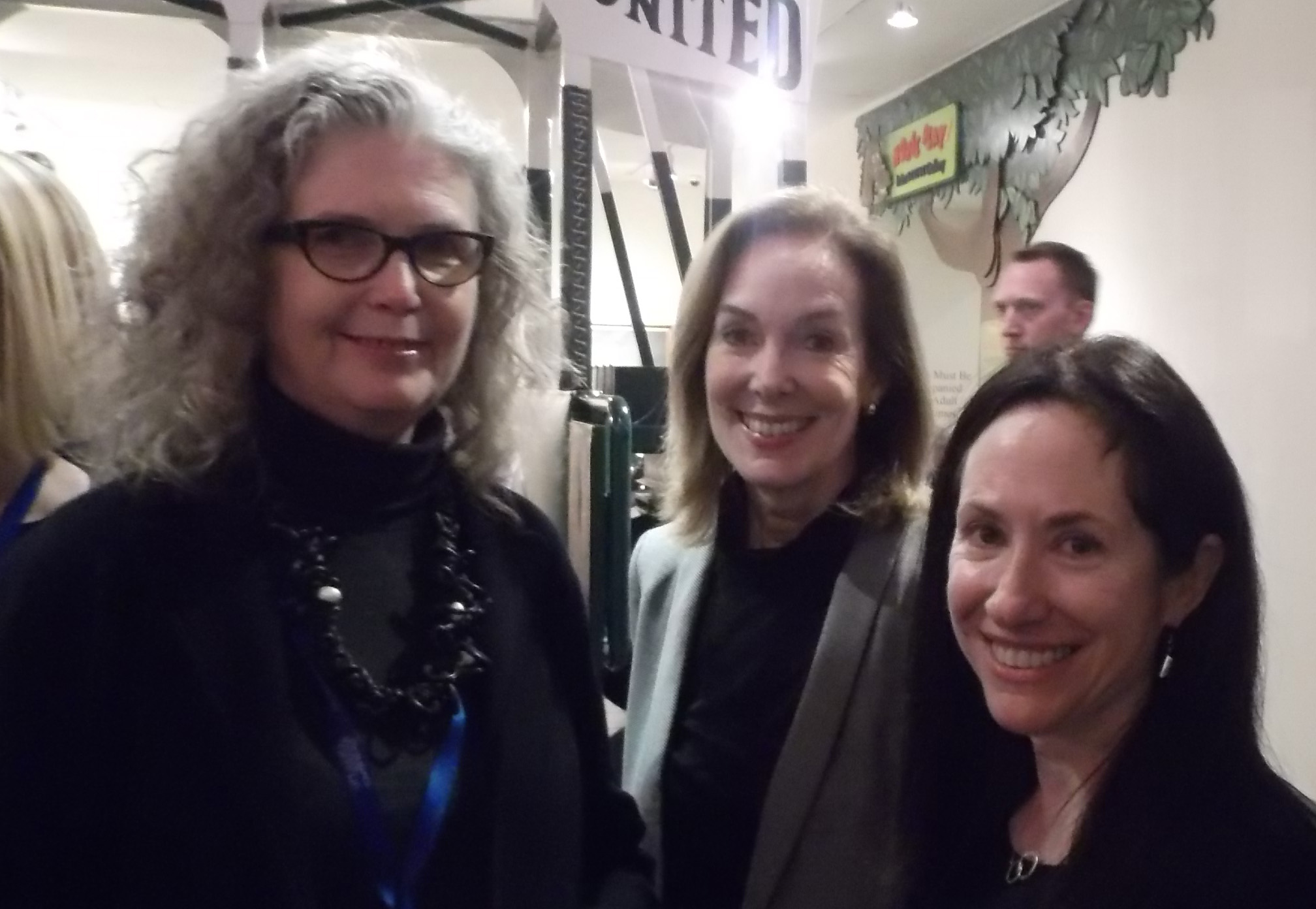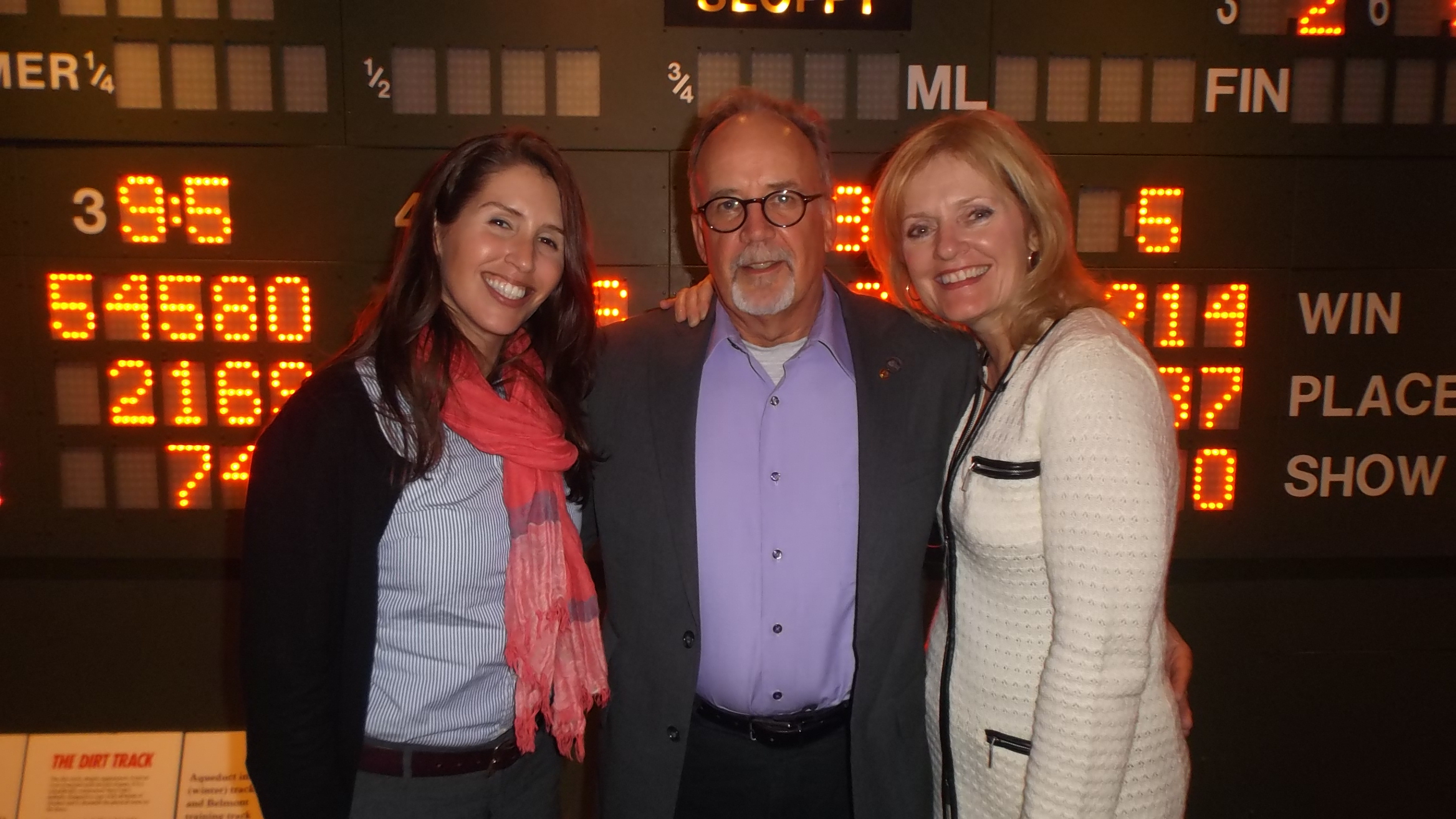by: Rick Bell FAIA Executive Director AIA New York
SARATOGA RACES AND ELECTIONS
The election of Margaret O’Donoghue Castillo, AIA, LEED AP, was the opening news at the AIA New York State Design Conference, which took place 10.09–10.11.14 in Saratoga Springs, NY. Castillo, currently AIANYS Vice President for Government Advocacy and 2011 AIANY President, was running for 2015 President-elect against AIANYS Board Secretary Ric Stott, AIA, a past-president of AIA Peconic. Other members of the 2015 AIANYS Executive Committee include 2015 President Tim Boyland, AIA; Immediate Past-President Ray Beeler, AIA; VP/Public Advocacy Marcus Marino, AIA; VP/Public Advocacy Robert Stark, AIA; Secretary Jeff Smith, AIA; Treasurer John Notaro, AIA; and Regional Representatives Burton Roslyn, FAIA, Randy Collins, AIA, and Jessica Sheridan, AIA. Saratoga warmly welcomed conference-goers from around the state and region with its stately architecture, walkable streets, music-filled bars, and tradition-rich equine culture. A highlight for some was the Saturday tour of the historic Saratoga Race Course, led by Samantha Bosshart of the Saratoga Preservation Foundation and Michael Phinney, AIA, of Saratoga-based Phinney Design Group. Racing for the season ends on Labor Day, but those present saw some thoroughbreds practicing in the brisk morning air, and stood on the recently-completed Whitney Viewing Platform at what is called the “Oklahoma Track” because it is so far away.
NEW PRACTICE / NEW DESIGN
The Saratoga Design Conference was an exploration of the dramatic changes taking place in the practice of architecture and the resulting innovative design work. The Design Conference’s primary purpose was to impart both practical and theoretical knowledge that will enable those attending to expand their areas of practice and increase their relevance. New partnerships were discussed with New York State’s schools of architecture to bring professionals academics closer together and help merge theory and practice. As AIANYS President Beeler put it, “New practice methodologies, such as research and evidence-based design, are transforming the profession and making our work more relevant to the needs of clients and the public.”
HONOR AWARDS
The 2014 AIA New York State Honor Awards were conferred at a gala dinner at the Saratoga Hilton on Friday, 10.10.14. The list of the service and achievement award winners included: Adrienne Bresnan, FAIA, and Joseph Bresnan, FAIA (Fellows Award); Margaret O’Donoghue Castillo, AIA, LEED AP, and John A. Notaro, AIA (Matthew W. Del Gaudio Awards); Dennis A. Andrejko, FAIA (Kideney Award), Gregg Pasquarelli, AIA (President’s Award); Linsey Graff, Assoc. AIA (Intern-Associate Award), Jodi Monroe, AIA, and Rebuild by Design (Community Development Awards); and Gensler, represented by Joe Brancato, AIA (Firm of the Year). Two additional awards were celebrated at Saturday’s closing “Rise and Shine” breakfast. They went to Deborah Gans, FAIA (Educator Award), and Jennifer (JD) Harper (Student Award).
DESIGN AWARDS
Design Awards were presented to architects for projects across New York State and the world. Representing the jury, David Lee, FAIA, conferred the Best in New York State Award to Caples Jefferson Architects for the Weeksville Heritage Center in Brooklyn. Sarah Caples, AIA, and Everardo Jefferson, AIA, were on hand to receive the accolades and a standing ovation from their peers. Other New York City-based firms winning project recognition included: ABA Studio/Andrew Bartle Architect; Amman & Whitney; Bade Stageberg Cox; Bernard Tschumi Architects; Beyer Blinder Belle Architects & Planners; Davis Brody Bond; FXFOWLE Architects; Gabellini Sheppard Associates; Gans Studio Architecture; Grimshaw Architects; Handel Architects; IBI Group · Gruzen Samton; Louise Braverman Architect; Kohn Pedersen Fox Associates; LTL Architects, Marvel Architects; Nicole Migeon Architect; Pelli Clarke Pelli Architects; Perkins Eastman; Rice+Lipka Architects; Ryall Port Sheridan Architects; SLCE Architects; Stantec; Steven Holl Architects; Thomas Balsley Associates; Voorsanger Architects; WASA/Studio A; Weiss/Manfredi; William Reue Architect; and WORK Architecture Company/WORKac. Other offices receiving design awards included: Architerra (Boston); Bates Masi + Architects (Sag Harbor); Bero Architecture (Rochester); Daniel Contelmo Architect (Poughkeepsie); Paulo Pereira Almeida Arq. (Portugal); Roger Ferris + Partners (Westport, CT); and 4RM+ULA (Saint Paul, MN).
KEYNOTE EVENTS
Corie Sharples, AIA, spoke about the different types of complexities discernible in achieving the interdisciplinary approach to architecture practiced by her firm, SHoP Architects. She said, “Architecture is a dense, messy network of ideas,” and that she would be speaking from the viewpoint of the collective, not the individual. Current projects, including a tall tower above the Steinway building on West 57th Street, were described, as was the latest phase of Manhattan’s East River Promenade. She noted that “Manhattan is almost more complicated in its political structure than in its physical one,” and that one had to learn to navigate the morass of regulatory approvals and client conflicts. The complexity of building affordable housing – and in particular modular housing– was discussed in the context of SHoP’s work at Atlantic Yards. The role of SHoP Construction also featured into Sharples’ description of alternative practice.
Scott Simpson, FAIA, president and CEO of The Stubbins Associates, Cambridge, MA, spoke about the importance of technology and how understanding big data could help save time and money. He started with a rhetorical question, asking: What does it mean for design when the computer technology that used to fill a room now fits in the palm of a hand? He asked, “What will tomorrow’s design studio look like?” His provocative answer was to expect radical change in the client experience, characterized by “no drawings, full collaboration, instant feedback, 4-D experience, and multi-sensory expectation.” Simpson noted that, with BIM and other new software, the means exist to eliminate shop drawings, re-submittals, and disputes, and said “not to take advantage of these tools is a shame – sort of like building a house without power tools or a skyscraper without a crane.”
Stephen Chung, AIA, the creator of the television series “Cool Spaces!: The Best New Architecture,” delivered a keynote address about how he moved from practice to media to better answer the question: “How can we better explain what architecture is, and what architects do in order to better engage the general public?” The widely seen public television series is sponsored by the AIA and Architect magazine. The show’s focus has been on how architects and clients work together, using both innovative technology and more traditional design practices to build exemplary structures and livable communities.
Richard Maimon, FAIA, of KieranTimberlake, delivered the Irving P. Marks Closing Keynote, speaking about the importance of having a research culture in his Philadelphia-based firm. Describing shortcuts to creating tools that will help us to do design better, he suggested that we need “real data to work with – not using rule of thumb, not guessing about the environmental characteristics of a building that we are renovating.” In regard to his firm’s current renovation of the School of Architecture at Tulane University in New Orleans, Maimon noted that his firm had “developed environmental sensors that had gotten small and better over the last few years.” He described how “simultaneous information has richness,” and suggested that we look more closely at the materials that we are using in construction, particularly in regard to the calibration between carbon content vs. recyclability and durability over time.
SELECTED PROGRAMS
Russ Davidson, FAIA, and Frank Pitts, FAIA, brought those attending up to speed on repositioning, structural changes at AIA National, and the state of national finances. In their “Rise and Shine” breakfast, Davidson started by reprising his “My View Forward” remarks from his successful campaign to be 2016 AIA National President. That eloquent statement noted: “The AIA must FOCUS on issues that no organization can or will tackle, the issues on which only the AIA is best-suited to make a difference. The bond formed by these common interests is what brings all members together.” He described the Public Awareness Plan that addresses how we can “change behaviors and perceptions, increase support for architecture, and create a deeper understanding of architecture and appreciation of the value of architects.” Pitts gave a positive report on finances, particularly in regard to the AIA National Component having some $38 million in reserves.
Joe Hogan, head of the Associated General Contractors of New York State, moderated a panel titled “Conversations from the Field: Effective Communications between Architects and Constructors.” Panelists included: F. Eric Goshow, FAIA (Goshow Architects), Robert Stark, AIA (Chantreuil Jensen Stark Architects), Dan Wilson, AIA (Spring Line Design), and Thomas LePage (Barr & Barr). One of Hogan’s initial questions was: “How do you align the different goals and objectives” of the various members of the project team? LePage answered, “The owner has to be part of it from the beginning,” and Wilson added, “You need to establish the lines of communication at the construction kick-off meeting.” Goshow, a past-president of AIA New York State, noted, “We are trying to get away from Design-Bid-Build. The lowest-price form of bidding creates an adversarial relationship.” After much spirited discussion, also including audience members Russ Davidson, FAIA, Kelly Hayes-McAlonie, AIA, and Burt Roslyn, FAIA, Hogan ended the program by saying that we can all agree that it starts with having a good client.
Dennis Andrejko, FAIA, introduced a “NYS Schools of Architecture Roundtable,” where issues of pedagogy and practice came together. He also represented the Rochester Institute of Technology (RIT) as Associate Professor and Program Chair of its Master of Architecture Program. The issues of academic structure, timing of licensure, and curricular content were addressed by representatives of four architecture programs in New York State. There for City College was Topaz Medallion-winner and Distinguished Professor Lance Jay Brown, FAIA, 2014 President of the AIA New York Chapter. Representing the School of Architecture and Design at NYIT was Associate Dean Frank Mruk, AIA, RIBA. The School of Architecture at RPI was represented by Associate Dean Mark Mistur, AIA. Joyce Hwang, AIA, Associate Professor and Director of Professional Studies spoke for the State University at Buffalo School of Architecture.
Emily Abruzzo, AIA, Co-founder of Abruzzo Bodziak Architects and the curator of the FitNation exhibition, spoke on a panel titled “Bicycles, Obersity, and Architecture.” Other New York Chapter members who were speakers in one or another session or tour included: Illya Azaroff, AIA (+LAB Architect); Peter Bachmann, AIA (JCJ Architecture); Breeze Glazer, AIA, and Robert Goodwin, AIA (Perkins+Will); Jill Lerner, FAIA (Kohn Pedersen Fox Associates); Ann Rolland, AIA (FXFOWLE); Burt Roslyn, FAIA (Roslyn Consultants); Jessica Sheridan, AIA, LEED AP (Gensler); Michael Syracuse (FXFOWLE); Mark Turkel, AIA, (Leroy Street Studio); Jay Valgora, AIA, AICP, LEED AP (STUDIO V Architecture); Shawn Watts, AIA (Leroy Street Studio); and Justin Whiteford (Kohn Pedersen Fox Associates). The 2014 AIANYS Design Conference and a most remarkable Product Showcase was organized and staffed by AIANYS Executive Director Georgi Ann Bailey, CAE, and her wonderful colleagues from the Institute’s Albany office: Michelle Brown, Katie Harlow, David Hodkinson, Stephanie Quirini, and Michael Burridge.
























